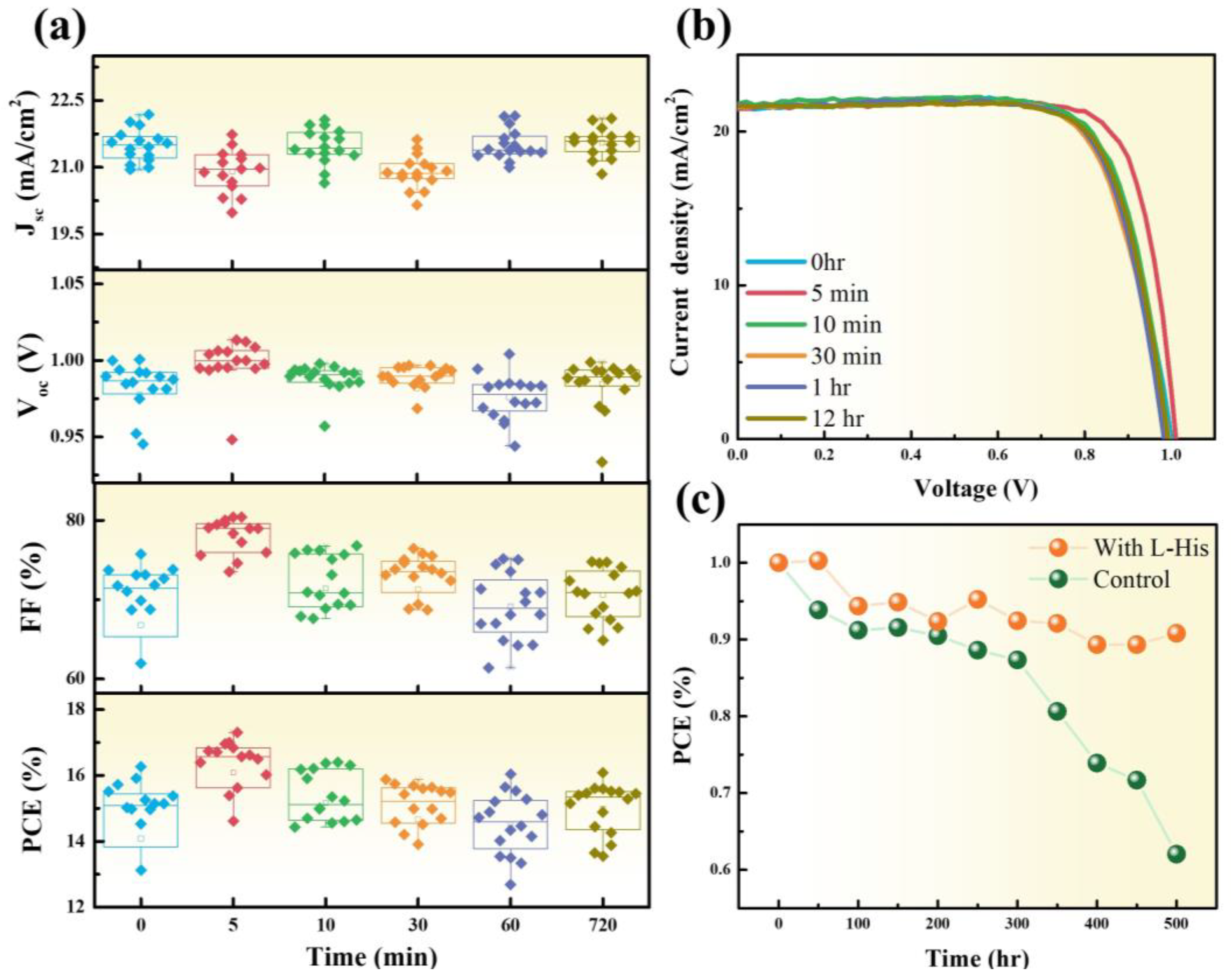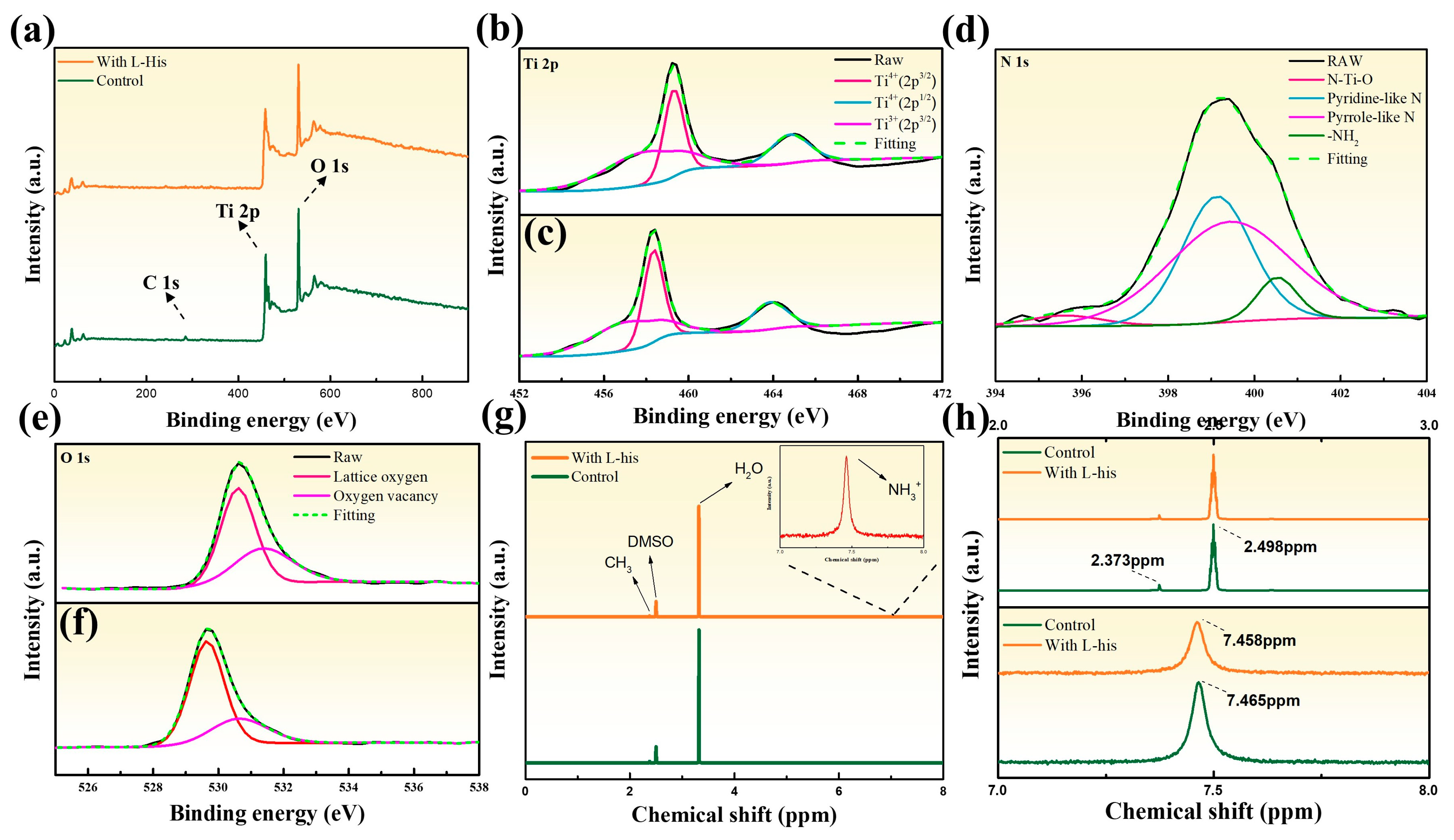Large-Area Perovskite Solar Module Produced by Introducing Self-Assembled L-Histidine Monolayer at TiO2 and Perovskite Interface
Abstract
:1. Introduction
2. Materials and Methods
2.1. Materials
2.2. Device Fabrication
2.3. Characterizations
3. Results and Discussion
4. Conclusions
Supplementary Materials
Author Contributions
Funding
Data Availability Statement
Acknowledgments
Conflicts of Interest
References
- Aydin, E.; Allen, T.G.; De Bastiani, M.; Razzaq, A.; Xu, L.; Ugur, E.; Liu, J.; De Wolf, S. Pathways toward commercial perovskite/silicon tandem photovoltaics. Science 2024, 383, eadh3849. [Google Scholar] [CrossRef] [PubMed]
- National Renewable Energy Laboratory. NREL Efficiency Chart. Available online: https://www.nrel.gov/pv/cell-efficiency.html (accessed on 3 August 2024).
- Da, P.; Zheng, G. Tailoring interface of lead-halide perovskite solar cells. Nano Res. 2017, 10, 1471–1497. [Google Scholar] [CrossRef]
- Huo, X.; Li, Y.; Liu, W.; Huang, X.; Meng, J.; Lu, Y.; Meng, N.; Zhang, Y.; Zhao, S.; Qiao, B.; et al. Nonpolar and Ultra-long-chain Ligand to Modify the Perovskite Interface toward High-Efficiency and Stable Wide Bandgap Perovskite Solar Cells. ACS Appl. Energy Mater. 2023, 6, 1731–1740. [Google Scholar] [CrossRef]
- Zeng, J.; Bi, L.; Cheng, Y.; Xu, B.; Jen, A.K.-Y. Self-assembled monolayer enabling improved buried interfaces in blade-coated perovskite solar cells for high efficiency and stability. Nano Res. Energy 2022, 1, e9120004. [Google Scholar] [CrossRef]
- Hu, J.; Wang, C.; Qiu, S.; Zhao, Y.; Gu, E.; Zeng, L.; Yang, Y.; Li, C.; Liu, X.; Forberich, K. Spontaneously self-assembly of a 2D/3D heterostructure enhances the efficiency and stability in printed perovskite solar cells. Adv. Energy Mater. 2020, 10, 2000173. [Google Scholar] [CrossRef]
- Mann, D.S.; Patil, P.; Kwon, S.-N.; Na, S.-I. Enhanced performance of pin perovskite solar cell via defect passivation of nickel oxide/perovskite interface with self-assembled monolayer. Appl. Surf. Sci. 2021, 560, 149973. [Google Scholar] [CrossRef]
- Han, F.; Hao, G.; Wan, Z.; Luo, J.; Xia, J.; Jia, C. Bifunctional electron transporting layer/perovskite interface linker for highly efficient perovskite solar cells. Electrochim. Acta 2019, 296, 75–81. [Google Scholar] [CrossRef]
- Shih, Y.; Wang, L.; Hsieh, H.; Lin, K. Enhancing the photocurrent of perovskite solar cells via modification of the TiO2/CH3NH3PbI3 heterojunction interface with amino acid. J. Mater. Chem. A 2015, 3, 9133–9136. [Google Scholar] [CrossRef]
- Hu, H.; Singh, M.; Wan, X.; Tang, J.; Chu, C.-W.; Li, G. Nucleation and crystal growth control for scalable solution-processed organic–inorganic hybrid perovskite solar cells. J. Mater. Chem. A 2020, 8, 1578–1603. [Google Scholar] [CrossRef]
- Deng, Y.; Zheng, X.; Bai, Y.; Wang, Q.; Zhao, J.; Huang, J. Surfactant-controlled ink drying enables high-speed deposition of perovskite films for efficient photovoltaic modules. Nat. Energy 2018, 3, 560–566. [Google Scholar] [CrossRef]
- Levine, I.; Al-Ashouri, A.; Musiienko, A.; Hempel, H.; Magomedov, A.; Drevilkauskaite, A.; Getautis, V.; Menzel, D.; Hinrichs, K.; Unold, T. Charge transfer rates and electron trapping at buried interfaces of perovskite solar cells. Joule 2021, 5, 2915–2933. [Google Scholar] [CrossRef]
- Al-Ashouri, A.; Köhnen, E.; Li, B.; Magomedov, A.; Hempel, H.; Caprioglio, P.; Márquez, J.A.; Morales Vilches, A.B.; Kasparavicius, E.; Smith, J.A. Monolithic perovskite/silicon tandem solar cell with >29% efficiency by enhanced hole extraction. Science 2020, 370, 1300–1309. [Google Scholar] [CrossRef] [PubMed]
- Al-Ashouri, A.; Magomedov, A.; Roß, M.; Jošt, M.; Talaikis, M.; Chistiakova, G.; Bertram, T.; Márquez, J.A.; Köhnen, E.; Kasparavičius, E. Conformal monolayer contacts with lossless interfaces for perovskite single junction and monolithic tandem solar cells. Energy Environ. Sci. 2019, 12, 3356–3369. [Google Scholar] [CrossRef]
- Aamir, M.; Adhikari, T.; Sher, M.; Revaprasadu, N.; Khalid, W.; Akhtar, J.; Nunzi, J.-M. Fabrication of planar heterojunction CsPbBr 2 I perovskite solar cells using ZnO as an electron transport layer and improved solar energy conversion efficiency. New J. Chem. 2018, 42, 14104–14110. [Google Scholar] [CrossRef]
- Kim, H.B.; Im, I.; Yoon, Y.; Do Sung, S.; Kim, E.; Kim, J.; Lee, W.I. Enhancement of photovoltaic properties of CH3NH3PbBr3 heterojunction solar cells by modifying mesoporous TiO2 surfaces with carboxyl groups. J. Mater. Chem. A 2015, 3, 9264–9270. [Google Scholar] [CrossRef]
- Du, J.; Wang, Y.; Zhang, Y.; Zhao, G.; Jia, Y.; Zhang, X.; Liu, Y. Ionic liquid-assisted improvements in the thermal stability of CH3NH3PbI3 perovskite photovoltaics. Phys. Status Solidi (RRL)-Rapid Res. Lett. 2018, 12, 1800130. [Google Scholar] [CrossRef]
- Du, J.; Feng, L.; Guo, X.; Huang, X.; Lin, Z.; Su, J.; Hu, Z.; Zhang, J.; Chang, J.; Hao, Y. Enhanced efficiency and stability of planar perovskite solar cells by introducing amino acid to SnO2/perovskite interface. J. Power Sources 2020, 455, 227974. [Google Scholar] [CrossRef]
- Sun, X.; Jiang, H.; Sun, Y.; Guo, Z.; Pang, Z.; Wang, F.; Yang, J.; Yang, L. Multi-functional L-histidine self-assembled monolayers on SnO2 electron transport layer to boost photovoltaic performance of perovskite solar cells. Electrochim. Acta 2022, 428, 140930. [Google Scholar] [CrossRef]
- Wu, W.; Dong, X.; Liu, G.; Pan, X.; Zheng, H. Regulating coordination by multi-configurational alkaloid-based passivation molecules for high-performance perovskite photovoltaics. Chem. Eng. J. 2023, 452, 139535. [Google Scholar] [CrossRef]
- Snaith, H.J.; Abate, A.; Ball, J.M.; Eperon, G.E.; Leijtens, T.; Noel, N.K.; Stranks, S.D.; Wang, J.T.-W.; Wojciechowski, K.; Zhang, W. Anomalous hysteresis in perovskite solar cells. J. Phys. Chem. Lett. 2014, 5, 1511–1515. [Google Scholar] [CrossRef]
- Hsu, H.-C.; Wu, S.-H.; Tung, Y.-L.; Shih, C.-F. Long-term stable perovskite solar cells prepared by doctor blade coating technology using bilayer structure and non-toxic solvent. Org. Electron. 2022, 101, 106400. [Google Scholar] [CrossRef]
- Hou, M.; Zhang, H.; Wang, Z.; Xia, Y.; Chen, Y.; Huang, W. Enhancing efficiency and stability of perovskite solar cells via a self-assembled dopamine interfacial layer. ACS Appl. Mater. Interfaces 2018, 10, 30607–30613. [Google Scholar] [CrossRef] [PubMed]
- Lin, C.-T.; Xu, W.; Macdonald, T.J.; Ngiam, J.; Kim, J.-H.; Du, T.; Xu, S.; Tuladhar, P.S.; Kang, H.; Lee, K. Correlating the active layer structure and composition with the device performance and lifetime of amino-acid-modified perovskite solar cells. ACS Appl. Mater. Interfaces 2021, 13, 43505–43515. [Google Scholar] [CrossRef] [PubMed]
- Hsiao, Y.-W.; Song, J.-Y.; Wu, H.-T.; Leu, C.-C.; Shih, C.-F. Properties of halide perovskite photodetectors with little rubidium incorporation. Nanomaterials 2022, 12, 157. [Google Scholar] [CrossRef] [PubMed]
- Shao, Y.; Xiao, Z.; Bi, C.; Yuan, Y.; Huang, J. Origin and elimination of photocurrent hysteresis by fullerene passivation in CH3NH3PbI3 planar heterojunction solar cells. Nat. Commun. 2014, 5, 5784. [Google Scholar] [CrossRef] [PubMed]
- Sun, C.; Wu, Z.; Yip, H.L.; Zhang, H.; Jiang, X.F.; Xue, Q.; Hu, Z.; Hu, Z.; Shen, Y.; Wang, M. Amino-functionalized conjugated polymer as an efficient electron transport layer for high-performance planar-heterojunction perovskite solar cells. Adv. Energy Mater. 2016, 6, 1501534. [Google Scholar] [CrossRef]
- Chang, C.-Y.; Wang, C.-P.; Raja, R.; Wang, L.; Tsao, C.-S.; Su, W.-F. High-efficiency bulk heterojunction perovskite solar cell fabricated by one-step solution process using single solvent: Synthesis and characterization of material and film formation mechanism. J. Mater. Chem. A 2018, 6, 4179–4188. [Google Scholar] [CrossRef]
- Xing, G.; Mathews, N.; Sun, S.; Lim, S.S.; Lam, Y.M.; Grätzel, M.; Mhaisalkar, S.; Sum, T.C. Long-range balanced electron-and hole-transport lengths in organic-inorganic CH3NH3PbI3. Science 2013, 342, 344–347. [Google Scholar] [CrossRef] [PubMed]
- Shaw, P.E.; Ruseckas, A.; Samuel, I.D. Exciton diffusion measurements in poly (3-hexylthiophene). Adv. Mater. 2008, 20, 3516–3520. [Google Scholar] [CrossRef]
- Bharti, B.; Kumar, S.; Kumar, R. Superhydrophilic TiO2 thin film by nanometer scale surface roughness and dangling bonds. Appl. Surf. Sci. 2016, 364, 51–60. [Google Scholar] [CrossRef]
- Zhang, Y.; Wang, Q.; Duan, K.; Wang, L.; Tao, L.; Zhang, J.; Wang, H.; Huo, Z. The effects of pyridine molecules structure on the defects passivation of perovskite solar cells. J. Solid State Electrochem. 2021, 25, 1531–1540. [Google Scholar] [CrossRef]
- Li, M.; Yu, L.; Zhang, Y.; Gao, H.; Li, P.; Chen, R.; Huang, W. Multiple passivation of electronic defects for efficient and stable perovskite solar cells. Sol. RRL 2020, 4, 2000481. [Google Scholar] [CrossRef]
- Di Valentin, C.; Pacchioni, G.; Selloni, A. Reduced and n-type doped TiO2: Nature of Ti3+ species. J. Phys. Chem. C 2009, 113, 20543–20552. [Google Scholar] [CrossRef]
- Finazzi, E.; Di Valentin, C.; Pacchioni, G.; Selloni, A. Excess electron states in reduced bulk anatase TiO2: Comparison of standard GGA, GGA+ U, and hybrid DFT calculations. J. Chem. Phys. 2008, 129, 154113. [Google Scholar] [CrossRef] [PubMed]
- Komolov, A.; Lazneva, E.; Gerasimova, N.; Panina, Y.A.; Sobolev, V.; Koroleva, A.; Pshenichnyuk, S.; Asfandiarov, N.; Modelli, A.; Handke, B. Conduction band electronic states of ultrathin layers of thiophene/phenylene co-oligomers on an oxidized silicon surface. J. Electron Spectrosc. Relat. Phenom. 2019, 235, 40–45. [Google Scholar] [CrossRef]
- Pronin, I.A.; Averin, I.A.; Karmanov, A.A.; Yakushova, N.D.; Komolov, A.S.; Lazneva, E.F.; Sychev, M.M.; Moshnikov, V.A.; Korotcenkov, G. Control over the surface properties of zinc oxide powders via combining mechanical, electron beam, and thermal processing. Nanomaterials 2022, 12, 1924. [Google Scholar] [CrossRef]
- Más-Montoya, M.; Curiel, D.; Wang, J.; Bruijnaers, B.J.; Janssen, R.A. Use of Sodium Diethyldithiocarbamate to Enhance the Open-Circuit Voltage of CH3NH3PbI3 Perovskite Solar Cells. Sol. RRL 2021, 5, 2000811. [Google Scholar] [CrossRef]
- Godinho, K.G.; Walsh, A.; Watson, G.W. Energetic and electronic structure analysis of intrinsic defects in SnO2. J. Phys. Chem. C 2009, 113, 439–448. [Google Scholar] [CrossRef]








| Structure/Device | Jsc (mA/cm2) | Voc (V) | FF (%) | PCE (%) |
|---|---|---|---|---|
| Control (single cell) | 21.45 | 1 | 75 | 16.26 |
| With L-His (single cell) | 21.51 | 1.01 | 79 | 17.30 |
| Control (module) | 1.97 | 12.30 | 55 | 13.56 |
| With L-His (module) | 1.82 | 12.39 | 73 | 16.54 |
Disclaimer/Publisher’s Note: The statements, opinions and data contained in all publications are solely those of the individual author(s) and contributor(s) and not of MDPI and/or the editor(s). MDPI and/or the editor(s) disclaim responsibility for any injury to people or property resulting from any ideas, methods, instructions or products referred to in the content. |
© 2024 by the authors. Licensee MDPI, Basel, Switzerland. This article is an open access article distributed under the terms and conditions of the Creative Commons Attribution (CC BY) license (https://creativecommons.org/licenses/by/4.0/).
Share and Cite
Hsu, H.-C.; Tsao, J.-C.; Yeh, C.-H.; Wu, H.-T.; Wu, C.-T.; Wu, S.-H.; Shih, C.-F. Large-Area Perovskite Solar Module Produced by Introducing Self-Assembled L-Histidine Monolayer at TiO2 and Perovskite Interface. Nanomaterials 2024, 14, 1315. https://doi.org/10.3390/nano14151315
Hsu H-C, Tsao J-C, Yeh C-H, Wu H-T, Wu C-T, Wu S-H, Shih C-F. Large-Area Perovskite Solar Module Produced by Introducing Self-Assembled L-Histidine Monolayer at TiO2 and Perovskite Interface. Nanomaterials. 2024; 14(15):1315. https://doi.org/10.3390/nano14151315
Chicago/Turabian StyleHsu, Hung-Chieh, Jung-Che Tsao, Cheng-Hsien Yeh, Hsuan-Ta Wu, Chien-Te Wu, Shih-Hsiung Wu, and Chuan-Feng Shih. 2024. "Large-Area Perovskite Solar Module Produced by Introducing Self-Assembled L-Histidine Monolayer at TiO2 and Perovskite Interface" Nanomaterials 14, no. 15: 1315. https://doi.org/10.3390/nano14151315







